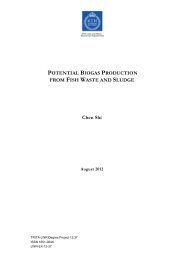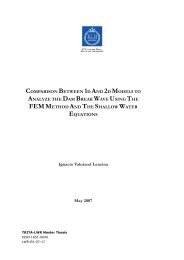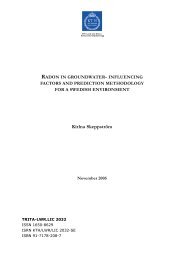water sources, infrastructure, space and the dynamics of ...
water sources, infrastructure, space and the dynamics of ...
water sources, infrastructure, space and the dynamics of ...
You also want an ePaper? Increase the reach of your titles
YUMPU automatically turns print PDFs into web optimized ePapers that Google loves.
Water <strong>sources</strong>, <strong>infrastructure</strong>, <strong>space</strong> <strong>and</strong> <strong>the</strong> <strong>dynamics</strong> <strong>of</strong> environmental diseases in Saboba District: Using GISABSTRACTThis research was undertaken in Saboba district <strong>of</strong> Nor<strong>the</strong>rn Ghana to examine <strong>the</strong> relationbetween <strong>water</strong> <strong>sources</strong>, <strong>infrastructure</strong> <strong>and</strong> <strong>space</strong> on one h<strong>and</strong> <strong>and</strong> <strong>dynamics</strong> <strong>of</strong> environmentaldiseases on <strong>the</strong> o<strong>the</strong>r. The specific causes <strong>of</strong> high environmental diseases in <strong>the</strong> district werealso identified. The top three leading diseases (Malaria, Typhoid <strong>and</strong> Respiratory TractInfections, RTI) in <strong>the</strong> district are environmental, wherein <strong>the</strong> first two is <strong>water</strong>-related. Thestudy discovered that <strong>the</strong>re was an inverse significant correlation between incidences <strong>of</strong>Malaria, Typhoid <strong>and</strong> RTI on one h<strong>and</strong> <strong>and</strong> distances to major town on <strong>the</strong> o<strong>the</strong>r. However,<strong>the</strong> correlation between <strong>the</strong> former <strong>and</strong> distances to <strong>water</strong>courses, roads, <strong>the</strong> type <strong>of</strong> l<strong>and</strong>cover <strong>and</strong> elevation (except malaria <strong>and</strong> distance to roads) had no significant relationship. Itwas discovered that women were disproportionately affected by environmental diseases. Thestudy also discovered that <strong>the</strong> immediate health threats for <strong>the</strong> people <strong>of</strong> Saboba district are<strong>the</strong> life <strong>and</strong> death immediacy <strong>of</strong> Malaria, Typhoid <strong>and</strong> respiratory diseases. These threats aremainly derived from synergic human causes from household environments, characterised byfar-from-door-clean-<strong>water</strong>, near-<strong>the</strong>-door-faeces, uncontrolled sewage, presence <strong>of</strong> dugout pits,frequent interruption <strong>of</strong> pipe <strong>water</strong>, poor waste disposal, poverty <strong>and</strong> illiteracy. For causes,<strong>the</strong> study concluded that <strong>the</strong> high rates <strong>of</strong> environmental diseases; especially malaria <strong>and</strong>Typhoid, were largely due to lack <strong>of</strong> <strong>and</strong>/or inappropriate infrastructural constructions. It issuggested that health <strong>of</strong>ficials in <strong>the</strong> district need to reprioritise health campaigns to createmore awareness on <strong>the</strong> commonest diseases in <strong>the</strong> district ra<strong>the</strong>r than tolling <strong>the</strong>international health campaign trends.Key words: Environmental diseases; Free-range; Space; Stagnant <strong>water</strong>; Waterrelateddiseasesiii
















